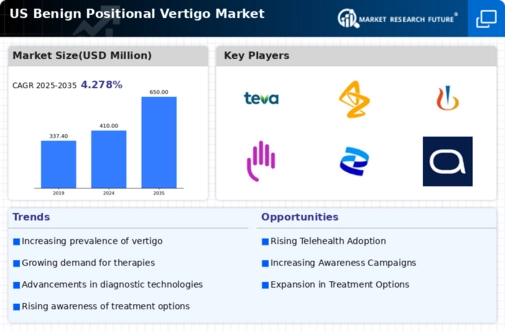The competitive insights of the US Benign Positional Vertigo Market reveal a landscape characterized by diverse players, innovative treatments, and evolving market dynamics. The market comprises pharmaceuticals, therapeutic solutions, and medical devices aimed at managing and treating benign paroxysmal positional vertigo. With a growing awareness of the condition and its impact on quality of life, companies are investing in research and development to bring forth effective treatments and enhance patient outcomes. The competitive rivalry is fueled by technological advancements and an increasing focus on patient-centric solutions, driving companies to differentiate their offerings and optimize their market strategies.
As the demand for effective treatment options rises, stakeholders are also focusing on compliance and regulatory approvals, which play a significant role in shaping market trends.
Merck and Co boasts a noteworthy presence in the US Benign Positional Vertigo Market, capitalizing on its robust portfolio of pharmaceuticals designed to address vestibular disorders. Its strengths lie in a strong reputation for reliability and efficacy, underpinned by extensive research capabilities that enable the development of innovative therapeutic solutions. Merck’s established distribution networks and partnerships further enhance its presence in the market, allowing seamless access to healthcare providers and patients alike. The company's commitment to high-quality standards and patient safety resonates well with both practitioners and consumers, reinforcing its position in a competitive landscape.
By leveraging clinical trial data and patient feedback, Merck and Co continues to refine its offerings, maintaining relevance in an evolving market and ensuring that they meet or exceed patient expectations.
Teva Pharmaceutical Industries is another key player in the US Benign Positional Vertigo Market, known for its generic and specialty medicines that cater to a wide range of health conditions, including vestibular disorders. The company emphasizes affordability and accessibility, making its products appealing to a broad demographic. Teva's strengths lie in its extensive product lineup and competitive pricing strategy, which allow it to capture market share through cost-effective solutions. The company has made strategic mergers and acquisitions to bolster its position and expand its therapeutic offerings in the US, consolidating its market presence further.
Through continuous innovation, Teva seeks to improve its product formulations and enhance patient experiences, aligning with current healthcare trends pivoting towards personalized medicine. By maintaining a focus on research and development, Teva Pharmaceutical Industries remains well-positioned to address the challenges and opportunities within the US Benign Positional Vertigo Market.




















